SKODA FABIA 2011 2.G / 5J Owner's Manual
Manufacturer: SKODA, Model Year: 2011, Model line: FABIA, Model: SKODA FABIA 2011 2.G / 5JPages: 220, PDF Size: 3.37 MB
Page 151 of 220
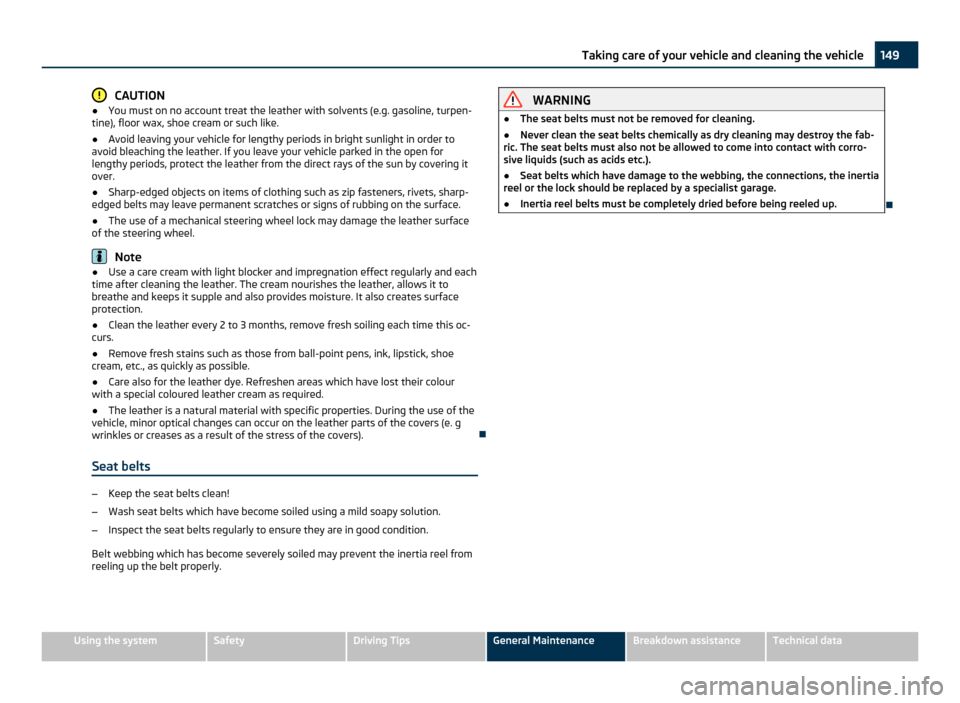
CAUTION
● You must on no account treat the leather with solvents (e.g. gasoline, turpen-
tine), floor wax, shoe cream or such like.
● Avoid leaving your vehicle for lengthy periods in bright sunlight in order to
avoid bleaching the leather. If you leave your vehicle parked in the open for
lengthy periods, protect the leather from the direct rays of the sun by covering it
over.
● Sharp-edged objects on items of clothing such as zip fasteners, rivets, sharp-
edged belts may leave permanent scratches or signs of rubbing on the surface.
● The use of a mechanical steering wheel lock may damage the leather surface
of the steering wheel. Note
● Use a care cream with light blocker and impregnation effect regularly and each
time after cleaning the leather. The cream nourishes the leather, allows it to
breathe and keeps it supple and also provides moisture. It also creates surface
protection.
● Clean the leather every 2 to 3 months, remove fresh soiling each time this oc-
curs.
● Remove fresh stains such as those from ball-point pens, ink, lipstick, shoe
cream, etc., as quickly as possible.
● Care also for the leather dye. Refreshen areas which have lost their colour
with a special coloured leather cream as required.
● The leather is a natural material with specific properties. During the use of the
vehicle, minor optical changes can occur on the leather parts of the covers (e. g
wrinkles or creases as a result of the stress of the covers).
Seat belts –
Keep the seat belts clean!
– Wash seat belts which have become soiled using a mild soapy solution.
– Inspect the seat belts regularly to ensure they are in good condition.
Belt webbing which has become severely soiled may prevent the inertia reel from
reeling up the belt properly. WARNING
● The seat belts must not be removed for cleaning.
● Never clean the seat belts chemically as dry cleaning may destroy the fab-
ric. The seat belts must also not be allowed to come into contact with corro-
sive liquids (such as acids etc.).
● Seat belts which have damage to the webbing, the connections, the inertia
reel or the lock should be replaced by a specialist garage.
● Inertia reel belts must be completely dried before being reeled up. 149
Taking care of your vehicle and cleaning the vehicle Using the system Safety Driving Tips General Maintenance Breakdown assistance Technical data
Page 152 of 220
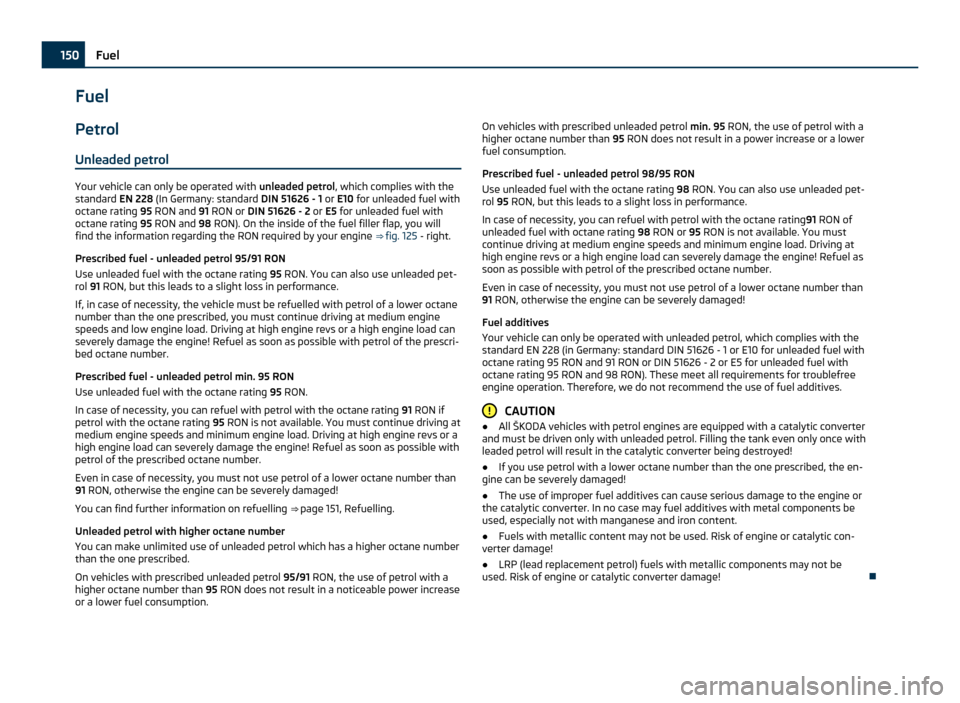
Fuel
Petrol
Unleaded petrol Your vehicle can only be operated with
unleaded petrol, which complies with the
standard EN 228 (In Germany: standard DIN 51626 - 1 or E10 for unleaded fuel with
octane rating 95 RON and 91 RON or DIN 51626 - 2 or E5 for unleaded fuel with
octane rating 95 RON and 98 RON). On the inside of the fuel filler flap, you will
find the information regarding the RON required by your engine ⇒
fig. 125 - right.
Prescribed fuel - unleaded petrol 95/91 RON
Use unleaded fuel with the octane rating 95 RON. You can also use unleaded pet-
rol 91 RON, but this leads to a slight loss in performance.
If, in case of necessity, the vehicle must be refuelled with petrol of a lower octane
number than the one prescribed, you must continue driving at medium engine
speeds and low engine load. Driving at high engine revs or a high engine load can
severely damage the engine! Refuel as soon as possible with petrol of the prescri-
bed octane number.
Prescribed fuel - unleaded petrol min. 95 RON
Use unleaded fuel with the octane rating 95 RON.
In case of necessity, you can refuel with petrol with the octane rating 91 RON if
petrol with the octane rating 95 RON is not available. You must continue driving at
medium engine speeds and minimum engine load. Driving at high engine revs or a
high engine load can severely damage the engine! Refuel as soon as possible with
petrol of the prescribed octane number.
Even in case of necessity, you must not use petrol of a lower octane number than
91 RON, otherwise the engine can be severely damaged!
You can find further information on refuelling ⇒ page 151, Refuelling.
Unleaded petrol with higher octane number
You can make unlimited use of unleaded petrol which has a higher octane number
than the one prescribed.
On vehicles with prescribed unleaded petrol 95/91 RON, the use of petrol with a
higher octane number than 95 RON does not result in a noticeable power increase
or a lower fuel consumption. On vehicles with prescribed unleaded petrol
min. 95 RON, the use of petrol with a
higher octane number than 95 RON does not result in a power increase or a lower
fuel consumption.
Prescribed fuel - unleaded petrol 98/95 RON
Use unleaded fuel with the octane rating 98 RON. You can also use unleaded pet-
rol 95 RON, but this leads to a slight loss in performance.
In case of necessity, you can refuel with petrol with the octane rating 91 RON of
unleaded fuel with octane rating 98 RON or
95 RON is not available. You must
continue driving at medium engine speeds and minimum engine load. Driving at
high engine revs or a high engine load can severely damage the engine! Refuel as
soon as possible with petrol of the prescribed octane number.
Even in case of necessity, you must not use petrol of a lower octane number than
91 RON, otherwise the engine can be severely damaged!
Fuel additives
Your vehicle can only be operated with unleaded petrol, which complies with the
standard EN 228 (in Germany: standard DIN 51626 - 1 or E10 for unleaded fuel with
octane rating 95 RON and 91 RON or DIN 51626 - 2 or E5 for unleaded fuel with
octane rating 95 RON and 98 RON). These meet all requirements for troublefree
engine operation. Therefore, we do not recommend the use of fuel additives. CAUTION
● All ŠKODA vehicles with petrol engines are equipped with a catalytic converter
and must be driven only with unleaded petrol. Filling the tank even only once with
leaded petrol will result in the catalytic converter being destroyed!
● If you use petrol with a lower octane number than the one prescribed, the en-
gine can be severely damaged!
● The use of improper fuel additives can cause serious damage to the engine or
the catalytic converter. In no case may fuel additives with metal components be
used, especially not with manganese and iron content.
● Fuels with metallic content may not be used. Risk of engine or catalytic con-
verter damage!
● LRP (lead replacement petrol)
fuels with metallic components may not be
used. Risk of engine or catalytic converter damage! 150
Fuel
Page 153 of 220
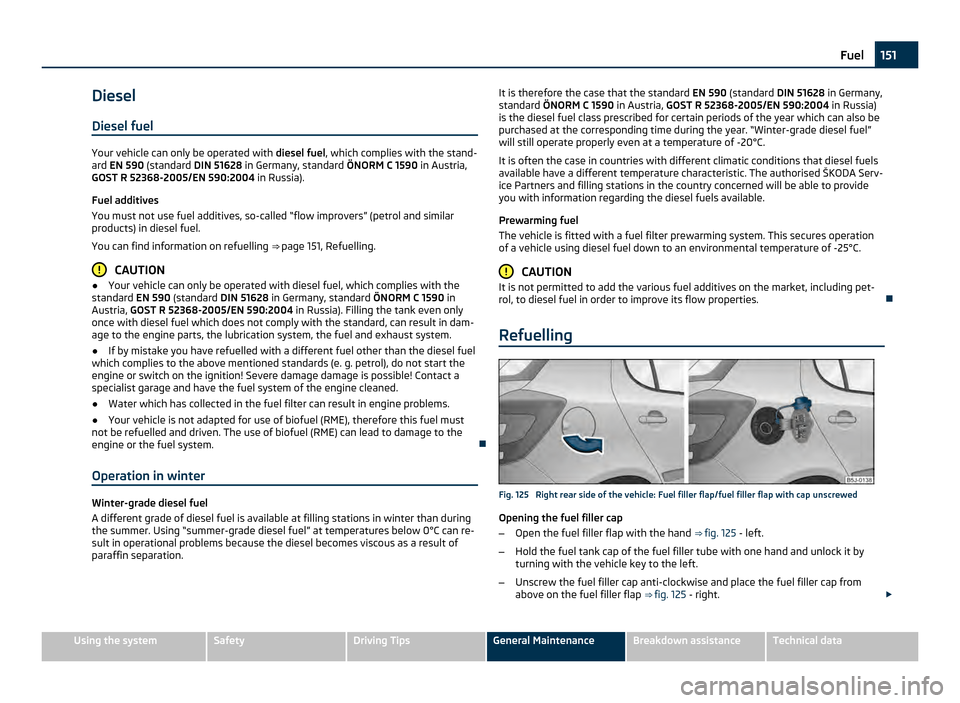
Diesel
Diesel fuel Your vehicle can only be operated with
diesel fuel, which complies with the stand-
ard EN 590 (standard DIN 51628 in Germany, standard ÖNORM C
1590 in Austria,
GOST R 52368-2005/EN 590:2004 in Russia).
Fuel additives
You must not use fuel additives, so-called “flow improvers” (petrol and similar
products) in diesel fuel.
You can find information on refuelling ⇒ page 151, Refuelling.CAUTION
● Your vehicle can only be operated with diesel fuel, which complies with the
standard EN 590 (standard DIN 51628 in Germany, standard ÖNORM C
1590 in
Austria, GOST R 52368-2005/EN 590:2004 in Russia). Filling the tank even only
once with diesel fuel which does not comply with the standard, can result in dam-
age to the engine parts, the lubrication system, the fuel and exhaust system.
● If by mistake you have refuelled with a different fuel other than the diesel fuel
which complies to the above mentioned standards (e. g. petrol), do not start the
engine or switch on the ignition! Severe damage damage is possible! Contact a
specialist garage and have the fuel system of the engine cleaned.
● Water which has collected in the fuel filter can result in engine problems.
● Your vehicle is not adapted for use of biofuel (RME), therefore this fuel must
not be refuelled and driven. The use of biofuel (RME) can lead to damage to the
engine or the fuel system.
Operation in winter Winter-grade diesel fuel
A different grade of diesel fuel is available at filling stations in winter than during
the summer. Using
“
summer-grade diesel fuel” at temperatures below 0°C can re-
sult in operational problems because the diesel becomes viscous as a result of
paraffin separation. It is therefore the case that the standard
EN 590 (standard DIN 51628 in Germany,
standard ÖNORM C 1590
in Austria, GOST R 52368-2005/EN 590:2004 in Russia)
is the diesel fuel class prescribed for certain periods of the year which can also be
purchased at the corresponding time during the year. “Winter-grade diesel fuel”
will still operate properly even at a temperature of -20°C.
It is often the case in countries with different climatic conditions that diesel fuels
available have a different temperature characteristic. The authorised ŠKODA Serv-
ice Partners and filling stations in the country concerned will be able to provide
you with information regarding the diesel fuels available.
Prewarming fuel
The vehicle is fitted with a fuel filter prewarming system. This secures operation
of a vehicle using diesel fuel down to an environmental temperature of -25°C. CAUTION
It is not permitted to add the various fuel additives on the market, including pet-
rol, to diesel fuel in order to improve its flow properties.
Refuelling Fig. 125 Right rear side of the vehicle: Fuel filler flap/fuel filler flap with cap unscrewed
Opening the fuel filler cap
–
Open the fuel filler flap with the hand ⇒ fig. 125
- left.
– Hold the fuel tank cap of the fuel filler tube with one hand and unlock it by
turning with the vehicle key to the left.
– Unscrew the fuel filler cap anti-clockwise and place the fuel filler cap from
above on the fuel filler flap ⇒ fig. 125 - right. £ 151
Fuel Using the system Safety Driving Tips General Maintenance Breakdown assistance Technical data
Page 154 of 220
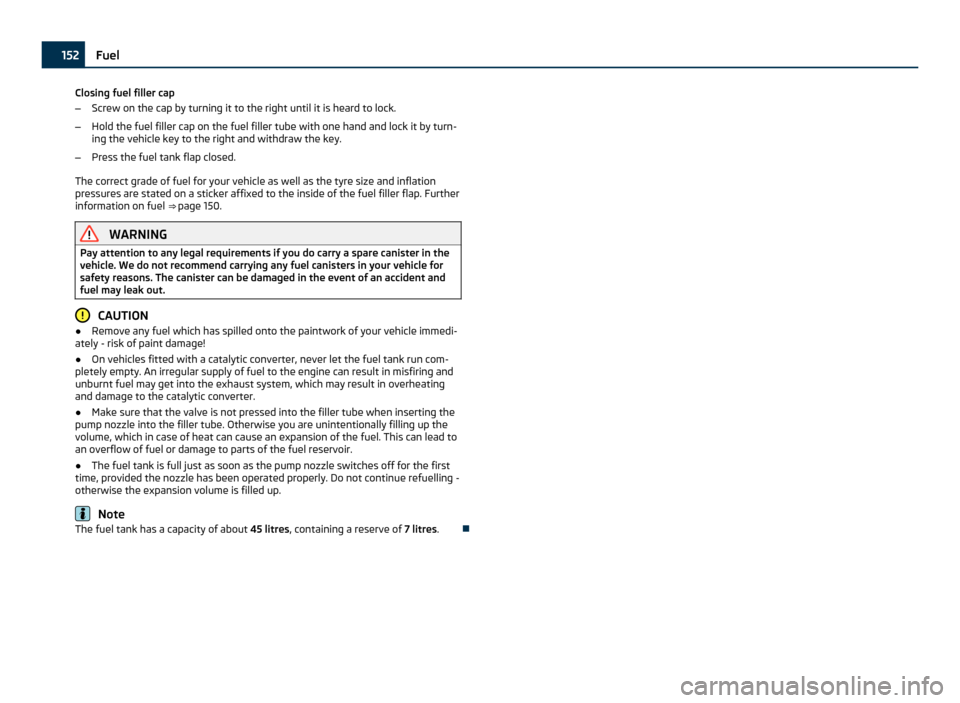
Closing fuel filler cap
–
Screw on the cap by turning it to the right until it is heard to lock.
– Hold the fuel filler cap on the fuel filler tube with one hand and lock it by turn-
ing the vehicle key to the right and withdraw the key.
– Press the fuel tank flap closed.
The correct grade of fuel for your vehicle as well as the tyre size and inflation
pressures are stated on a sticker affixed to the inside of the fuel filler flap. Further
information on fuel ⇒
page 150.WARNING
Pay attention to any legal requirements if you do carry a spare canister in the
vehicle. We do not recommend carrying any fuel canisters in your vehicle for
safety reasons. The canister can be damaged in the event of an accident and
fuel may leak out. CAUTION
● Remove any fuel which has spilled onto the paintwork of your vehicle immedi-
ately - risk of paint damage!
● On vehicles fitted with a catalytic converter, never let the fuel tank run com-
pletely empty. An irregular supply of fuel to the engine can result in misfiring and
unburnt fuel may get into the exhaust system, which may result in overheating
and damage to the catalytic converter.
● Make sure that the valve is not pressed into the filler tube when inserting the
pump nozzle into the filler tube. Otherwise you are unintentionally filling up the
volume, which in case of heat can cause an expansion of the fuel. This can lead to
an overflow of fuel or damage to parts of the fuel reservoir.
● The fuel tank is full just as soon as the pump nozzle switches off for the first
time, provided the nozzle has been operated properly. Do not continue refuelling -
otherwise the expansion volume is filled up. Note
The fuel tank has a capacity of about 45 litres, containing a reserve of 7 litres.152
Fuel
Page 155 of 220
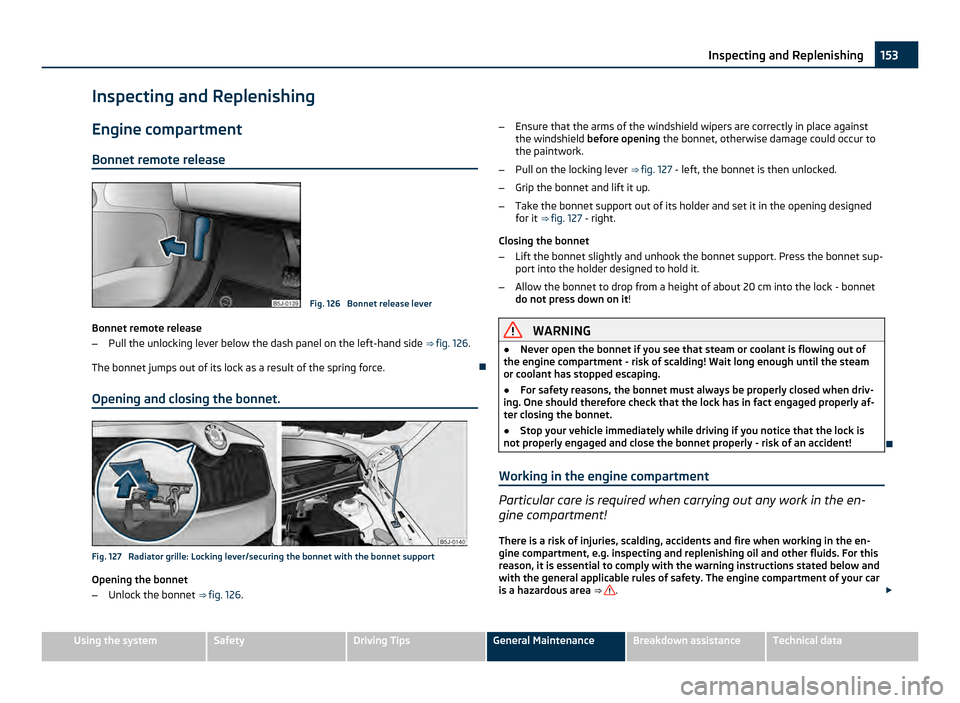
Inspecting and Replenishing
Engine compartment
Bonnet remote release Fig. 126 Bonnet release lever
Bonnet remote release
– Pull the unlocking lever below the dash panel on the left-hand side ⇒
fig. 126 .
The bonnet jumps out of its lock as a result of the spring force.
Opening and closing the bonnet. Fig. 127 Radiator grille: Locking lever/securing the bonnet with the bonnet support
Opening the bonnet
–
Unlock the bonnet ⇒
fig. 126 . –
Ensure that the arms of the windshield wipers are correctly in place against
the windshield before opening
the bonnet, otherwise damage could occur to
the paintwork.
– Pull on the locking lever ⇒ fig. 127 - left, the bonnet is then unlocked.
– Grip the bonnet and lift it up.
– Take the bonnet support out of its holder and set it in the opening designed
for it ⇒ fig. 127 - right.
Closing the bonnet
– Lift the bonnet slightly and unhook the bonnet support. Press the bonnet sup-
port into the holder designed to hold it.
– Allow the bonnet to drop from a height of about 20 cm into the lock - bonnet
do not press down on it! WARNING
● Never open the bonnet if you see that steam or coolant is flowing out of
the engine compartment - risk of scalding! Wait long enough until the steam
or coolant has stopped escaping.
● For safety reasons, the bonnet must always be properly closed when driv-
ing. One should therefore check that the lock has in fact engaged properly af-
ter closing the bonnet.
● Stop your vehicle immediately while driving if you notice that the lock is
not properly engaged and close the bonnet properly - risk of an accident!
Working in the engine compartment Particular care is required when carrying out any work in the en-
gine compartment!
There is a risk of injuries, scalding, accidents and fire when working in the en-
gine compartment, e.g. inspecting and replenishing oil and other fluids. For this
reason, it is essential to comply with the warning instructions stated below and
with the general applicable rules of safety. The engine compartment of your car
is a hazardous area ⇒ .
£ 153
Inspecting and Replenishing Using the system Safety Driving Tips General Maintenance Breakdown assistance Technical data
Page 156 of 220
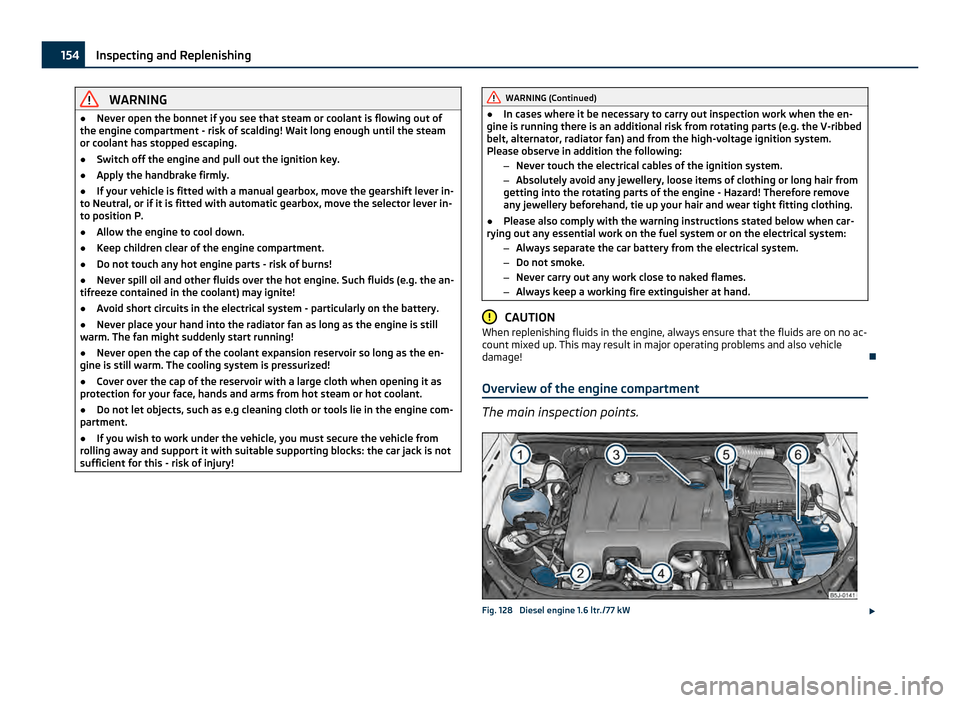
WARNING
● Never open the bonnet if you see that steam or coolant is flowing out of
the engine compartment - risk of scalding! Wait long enough until the steam
or coolant has stopped escaping.
● Switch off the engine and pull out the ignition key.
● Apply the handbrake firmly.
● If your vehicle is fitted with a manual gearbox, move the gearshift lever in-
to Neutral, or if it is fitted with automatic gearbox, move the selector lever in-
to position P
.
● Allow the engine to cool down.
● Keep children clear of the engine compartment.
● Do not touch any hot engine parts - risk of burns!
● Never spill oil and other fluids over the hot engine. Such fluids (e.g. the an-
tifreeze contained in the coolant) may ignite!
● Avoid short circuits in the electrical system - particularly on the battery.
● Never place your hand into the radiator fan as long as the engine is still
warm. The fan might suddenly start running!
● Never open the cap of the coolant expansion reservoir so long as the en-
gine is still warm. The cooling system is pressurized!
● Cover over the cap of the reservoir with a large cloth when opening it as
protection for your face, hands and arms from hot steam or hot coolant.
● Do not let objects, such as e.g cleaning cloth or tools lie in the engine com-
partment.
● If you wish to work under the vehicle, you must secure the vehicle from
rolling away and support it with suitable supporting blocks: the car jack is not
sufficient for this - risk of injury! WARNING (Continued)
● In cases where it be necessary to carry out inspection work when the en-
gine is running there is an additional risk from rotating parts (e.g. the V-ribbed
belt, alternator, radiator fan) and from the high-voltage ignition system.
Please observe in addition the following:
–Never touch the electrical cables of the ignition system.
– Absolutely avoid any jewellery, loose items of clothing or long hair from
getting into the rotating parts of the engine - Hazard! Therefore remove
any jewellery beforehand, tie up your hair and wear tight fitting clothing.
● Please also comply with the warning instructions stated below when car-
rying out any essential work on the fuel system or on the electrical system:
–Always separate the car battery from the electrical system.
– Do not smoke.
– Never carry out any work close to naked flames.
– Always keep a working fire extinguisher at hand. CAUTION
When replenishing fluids in the engine, always ensure that the fluids are on no ac-
count mixed up. This may result in major operating problems and also vehicle
damage!
Overview of the engine compartment The main inspection points.
Fig. 128 Diesel engine 1.6 ltr./77 kW
£154
Inspecting and Replenishing
Page 157 of 220
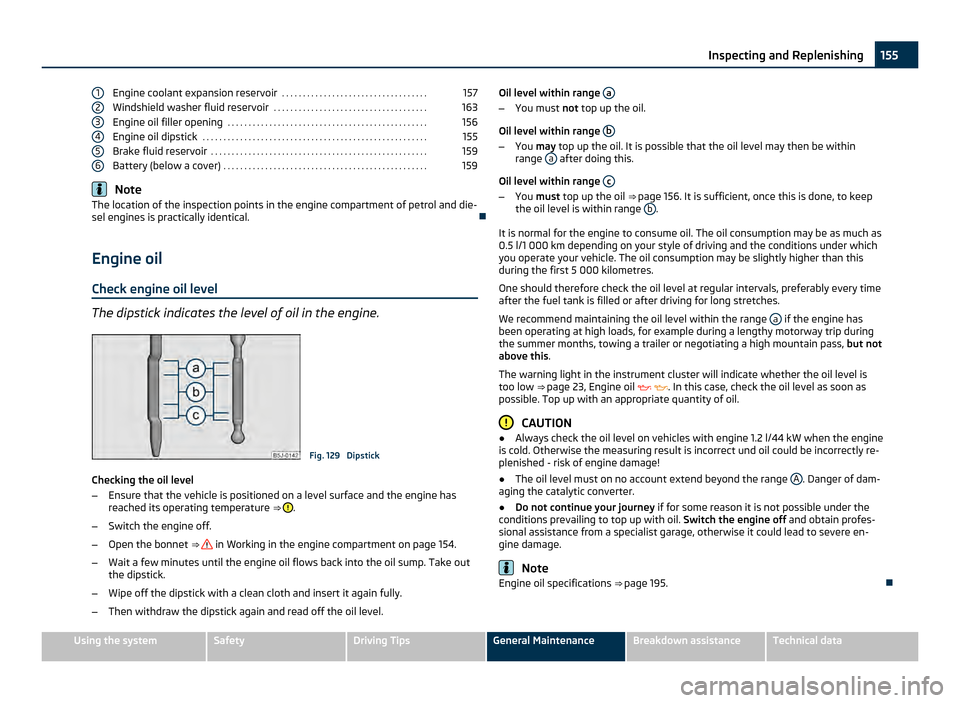
Engine coolant expansion reservoir
. . . . . . . . . . . . . . . . . . . . . . . . . . . . . . . . . . . 157
Windshield washer fluid reservoir . . . . . . . . . . . . . . . . . . . . . . . . . . . . . . . . . . . . . 163
Engine oil filler opening . . . . . . . . . . . . . . . . . . . . . . . . . . . . . . . . . . . . . . . . . . . . . . . . 156
Engine oil dipstick . . . . . . . . . . . . . . . . . . . . . . . . . . . . . . . . . . . . . . . . . . . . . . . . . . . . . . 155
Brake fluid reservoir . . . . . . . . . . . . . . . . . . . . . . . . . . . . . . . . . . . . . . . . . . . . . . . . . . . . 159
Battery (below a cover) . . . . . . . . . . . . . . . . . . . . . . . . . . . . . . . . . . . . . . . . . . . . . . . . . 159Note
The location of the inspection points in the engine compartment of petrol and die-
sel engines is practically identical.
Engine oil Check engine oil level The dipstick indicates the level of oil in the engine.
Fig. 129 Dipstick
Checking the oil level
– Ensure that the vehicle is positioned on a level surface and the engine has
reached its operating temperature ⇒ .
– Switch the engine off.
– Open the bonnet ⇒ in Working in the engine compartment on page 154.
– Wait a few minutes until the engine oil flows back into the oil sump. Take out
the dipstick.
– Wipe off the dipstick with a clean cloth and insert it again fully.
– Then withdraw the dipstick again and read off the oil level.
1 2
3
4
5
6 Oil level within range
a –
You must not top up the oil.
Oil level within range b –
You may top up the oil. It is possible that the oil level may then be within
range a after doing this.
Oil level within range c –
You must top up the oil ⇒ page 156. It is sufficient, once this is done, to keep
the oil level is within range b .
It is normal for the engine to consume oil. The oil consumption may be as much as
0.5 l/1 000 km depending on your style of driving and the conditions under which
you operate your vehicle. The oil consumption may be slightly higher than this
during the first 5 000 kilometres.
One should therefore check the oil level at regular intervals, preferably every time
after the fuel tank is filled or after driving for long stretches.
We recommend maintaining the oil level within the range a if the engine has
been operating at high loads, for example during a lengthy motorway trip during
the summer months, towing a trailer or negotiating a high mountain pass, but not
above this .
The warning light in the instrument cluster will indicate whether the oil level is
too low ⇒ page 23, Engine oil . In this case, check the oil level as soon as
possible. Top up with an appropriate quantity of oil. CAUTION
● Always check the oil level on vehicles with engine 1.2 l/44 kW when the engine
is cold. Otherwise the measuring result is incorrect und oil could be incorrectly re-
plenished - risk of engine damage!
● The oil level must on no account extend beyond the range A . Danger of dam-
aging the catalytic converter.
● Do not continue your journey if for some reason it is not possible under the
conditions prevailing to top up with oil. Switch the engine off and obtain profes-
sional assistance from a specialist garage, otherwise it could lead to severe en-
gine damage. Note
Engine oil specifications ⇒ page 195. 155
Inspecting and Replenishing Using the system Safety Driving Tips General Maintenance Breakdown assistance Technical data
Page 158 of 220
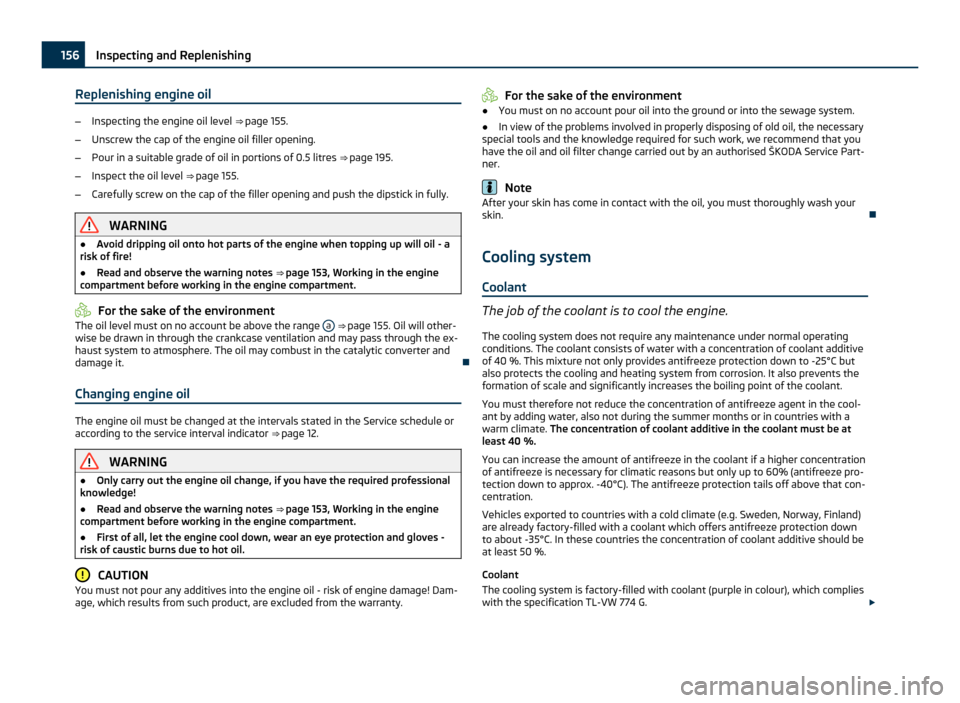
Replenishing engine oil
–
Inspecting the engine oil level ⇒ page 155.
– Unscrew the cap of the engine oil filler opening.
– Pour in a suitable grade of oil in portions of 0.5 litres ⇒
page 195.
– Inspect the oil level ⇒
page 155.
– Carefully screw on the cap of the filler opening and push the dipstick in fully. WARNING
● Avoid dripping oil onto hot parts of the engine when topping up will oil - a
risk of fire!
● Read and observe the warning notes ⇒
page 153, Working in the engine
compartment before working in the engine compartment. For the sake of the environment
The oil level must on no account be above the range a ⇒ page 155. Oil will other-
wise be drawn in through the crankcase ventilation and may pass through the ex-
haust system to atmosphere. The oil may combust in the catalytic converter and
damage it.
Changing engine oil The engine oil must be changed at the intervals stated in the Service schedule or
according to the service interval indicator
⇒ page 12.WARNING
● Only carry out the engine oil change, if you have the required professional
knowledge!
● Read and observe the warning notes ⇒
page 153, Working in the engine
compartment before working in the engine compartment.
● First of all, let the engine cool down, wear an eye protection and gloves -
risk of caustic burns due to hot oil. CAUTION
You must not pour any additives into the engine oil - risk of engine damage! Dam-
age, which results from such product, are excluded from the warranty. For the sake of the environment
● You must on no account pour oil into the ground or into the sewage system.
● In view of the problems involved in properly disposing of old oil, the necessary
special tools and the knowledge required for such work, we recommend that you
have the oil and oil filter change carried out by an authorised ŠKODA Service Part-
ner. Note
After your skin has come in contact with the oil, you must thoroughly wash your
skin.
Cooling system
Coolant The job of the coolant is to cool the engine.
The cooling system does not require any maintenance under normal operating
conditions. The coolant consists of water with a concentration of coolant additive
of 40 %. This mixture not only provides antifreeze protection down to -25°C but
also protects the cooling and heating system from corrosion. It also prevents the
formation of scale and significantly increases the boiling point of the coolant.
You must therefore not reduce the concentration of antifreeze agent in the cool- ant by adding water, also not during the summer months or in countries with a
warm climate. The concentration of coolant additive in the coolant must be at
least 40 %.
You can increase the amount of antifreeze in the coolant if a higher concentration
of antifreeze is necessary for climatic reasons but only up to 60% (antifreeze pro- tection down to approx. -40°C). The antifreeze protection tails off above that con-
centration.
Vehicles exported to countries with a cold climate (e.g. Sweden, Norway, Finland)
are already factory-filled with a coolant which offers antifreeze protection down
to about -35°C. In these countries the concentration of coolant additive should be
at least 50 %.
Coolant
The cooling system is factory-filled with coolant (purple in colour), which complies
with the specification TL-VW 774
G. £156
Inspecting and Replenishing
Page 159 of 220

When refilling, we only recommend you use the same antifreeze described on the
antifreeze expansion tank.
Please contact an authorised
ŠKODA
Service Partner if you have any questions re-
garding the coolant or if you wish to fill up with a different coolant.
An authorised ŠKODA Service Partner can also supply you with the correct coolant
additives.
Coolant capacity Petrol engines Capacities (in liter)
1.2 ltr./44 kW - EU5 5,5
1.2 l/51 kW - EU5 / EU2 DDK 5,5
1.2 ltr./63 kW TSI - EU5 7,7
1.2 ltr./77 kW TSI - EU5 7,7
1.4 ltr./63 kW - EU5 5,5
1.4 ltr./132 kW TSI - EU5 6,6
1.6 ltr./77 kW - EU4/EU2 DDK 5,5
Diesel engines Capacities (in liter)
1.2 ltr./55 kW TDI CR DPF - EU5 6,6
1.6 ltr./55 kW TDI CR DPF - EU5 8,4
1.6 ltr./66 kW TDI CR DPF - EU5 8,4
1.6 ltr./77 kW TDI CR DPF - EU5 8,4
CAUTION
● Other coolant additives may cause operational problems which, in particular,
involves significantly reducing the anticorrosion effect.
● Any faults or problems resulting from corrosion may cause a loss of coolant
and, as a consequence of this, result in major engine damage. Inspecting the coolant level Fig. 130 Engine compartment: Coolant
expansion bottle
The coolant expansion bottle is located in the engine compartment on the right.
– Switch the engine off.
– Open the bonnet ⇒ in Working in the engine compartment on page 154.
– Check the level of coolant in the coolant expansion bottle ⇒ fig. 130. The cool-
ant level when the engine is cold must lie between the “MIN” B and “MAX”
A markings. The level may also rise slightly above the “MAX” marking when the
engine is warm.
If the coolant level in the reservoir is too low, this is indicated by the warning light
in the instrument cluster
⇒ page 23. We still recommend inspecting the coolant
level directly at the reservoir from time to time.
Loss of coolant
A loss of coolant is first and foremost an indication of a leak in the system. You
should not merely top up the coolant in the reservoir. It is also important to have
the cooling system inspected without delay by a specialist garage.
Losses can only occur through the pressure relief in the cap of the coolant expan-
sion bottle which is completely free of leaks if the coolant boils as a result of over-
heating and is forced out of the cooling system. WARNING
Read and observe the warning notes ⇒ page 153,
Working in the engine com-
partment before working in the engine compartment. £ 157
Inspecting and Replenishing Using the system Safety Driving Tips General Maintenance Breakdown assistance Technical data
Page 160 of 220
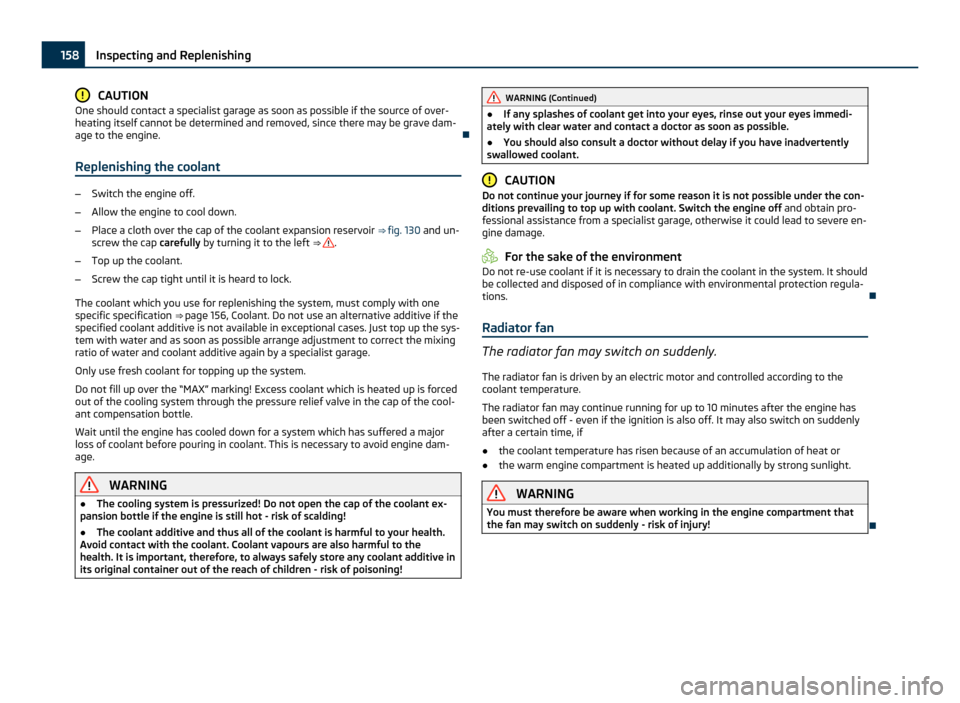
CAUTION
One should contact a specialist garage as soon as possible if the source of over-
heating itself cannot be determined and removed, since there may be grave dam-
age to the engine.
Replenishing the coolant –
Switch the engine off.
– Allow the engine to cool down.
– Place a cloth over the cap of the coolant expansion reservoir ⇒ fig. 130 and un-
screw the cap carefully by turning it to the left ⇒ .
– Top up the coolant.
– Screw the cap tight until it is heard to lock.
The coolant which you use for replenishing the system, must comply with one
specific specification ⇒ page 156 ,
Coolant. Do not use an alternative additive if the
specified coolant additive is not available in exceptional cases. Just top up the sys-
tem with water and as soon as possible arrange adjustment to correct the mixing
ratio of water and coolant additive again by a specialist garage.
Only use fresh coolant for topping up the system.
Do not fill up over the “MAX” marking! Excess coolant which is heated up is forced
out of the cooling system through the pressure relief valve in the cap of the cool-
ant compensation bottle.
Wait until the engine has cooled down for a system which has suffered a major
loss of coolant before pouring in coolant. This is necessary to avoid engine dam-
age. WARNING
● The cooling system is pressurized! Do not open the cap of the coolant ex-
pansion bottle if the engine is still hot - risk of scalding!
● The coolant additive and thus all of the coolant is harmful to your health.
Avoid contact with the coolant. Coolant vapours are also harmful to the
health. It is important, therefore, to always safely store any coolant additive in
its original container out of the reach of children - risk of poisoning! WARNING (Continued)
● If any splashes of coolant get into your eyes, rinse out your eyes immedi-
ately with clear water and contact a doctor as soon as possible.
● You should also consult a doctor without delay if you have inadvertently
swallowed coolant. CAUTION
Do not continue your journey if for some reason it is not possible under the con-
ditions prevailing to top up with coolant. Switch the engine off and obtain pro-
fessional assistance from a specialist garage, otherwise it could lead to severe en-
gine damage. For the sake of the environment
Do not re-use coolant if it is necessary to drain the coolant in the system. It should
be collected and disposed of in compliance with environmental protection regula-
tions.
Radiator fan The radiator fan may switch on suddenly.
The radiator fan is driven by an electric motor and controlled according to the
coolant temperature.
The radiator fan may continue running for up to 10 minutes after the engine has
been switched off - even if the ignition is also off. It may also switch on suddenly
after a certain time, if
● the coolant temperature has risen because of an accumulation of heat or
● the warm engine compartment is heated up additionally by strong sunlight. WARNING
You must therefore be aware when working in the engine compartment that
the fan may switch on suddenly - risk of injury! 158
Inspecting and Replenishing